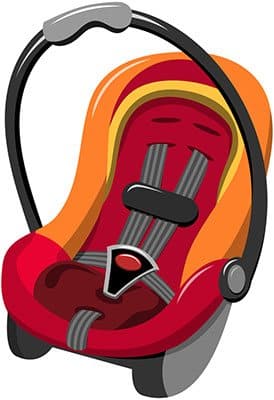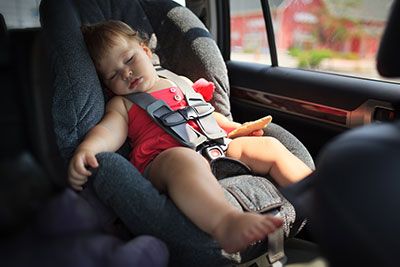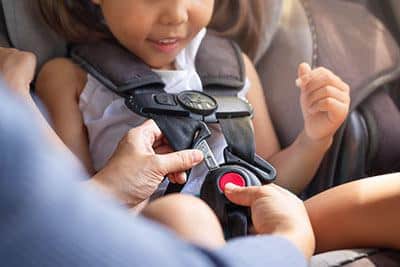As parents, we are responsible for ensuring our children are safe whenever they're in the car. And that means making sure they're fastened into their car seats correctly—which includes accounting for those pesky chest clips!
Many of us parents may not even know what these clips are or why they are so important. So, let's explore the essential information about car seat chest clips and how utilizing them can help ensure your kids stay snug and secure on any ride.
More...
Take Away Key Points:
What you must know about the chest clip placement car seat offers
If you want to learn more about the chest clip, its function in the car seat, and how it works properly, refer to our guide below. We've gathered reliable information to teach you about the chest clip.
1. What is a chest clip?
A car seat chest clip is a device that attaches to the harness of a car seat and clips together at the child's chest level. It helps keep the harness straps in place, preventing children from slipping out or taking their arms out of the straps.
The chest clip should be positioned anywhere in the mid to upper chest area, usually at armpit level. It is important to note that while some car seats include a chest clip, it is not legally required.

2. What is the main purpose of the chest clip?
The main purpose of the chest clip is to help keep the harness in place and ensure it is properly tensioned. This helps keep the child secure in their seat during a crash and prevents them from slipping out of the harness.
Additionally, some chest clips are designed to act as a pre-crash positioner, helping to keep the child in an optimal position before a crash occurs.
3. How does a chest clip work?
A chest clip is an important safety feature designed to keep the shoulder straps of a car seat in the correct position before a crash. The chest clip should be positioned anywhere in the mid to upper chest area, usually at armpit level.
It is important that the chest clip is placed correctly with the buckle centered over your child's sternum and not under their arm or near their neck.
This ensures that the shoulder straps are at or above your child's shoulders when forward-facing and level with or just below their shoulders when rear-facing.
4. How do you use the chest clip on the car seat harness straps?
Using a chest clip is vital in keeping your child safe in the car. The chest clip should be positioned at armpit level and should be snugly fastened across the chest. In addition, it's important to make sure that the straps are parallel over the torso, as this will help keep your child secure in the event of a crash.
When positioning the chest clip, it's also essential to ensure it isn't too tight or loose. Too tight can cause discomfort for your child; if it's too loose, it won't provide enough protection in a crash.
It's also important to check that the chest clip is securely fastened before each journey. This will help ensure that your child remains secure throughout their journey.
For the rear-facing seat, the straps are installed in the harness slots below or at and close to the child's shoulders. For the forward-facing child restraint, the straps are installed in the harness slots above or closest to the child's shoulders.
So, when adequately buckled and installed into the crotch strap, the harness ensures your child is safe and secure in the seat. The harness will also distribute the crash forces adequately to ensure your child is intact.

5. What are the chest clip types?
Chest clips come in a variety of types. The most common type is the pre-crash positioner, which helps to keep the child in the proper position before a crash occurs.
Other types include anti-escape harness clips, which help prevent children from taking their arms out of high chair straps, and chest clips positioned over steel bolts for crash-testing purposes.
Many car seat manufacturers also offer chest clips that can be adjusted to fit different sizes and shapes of chests. No matter what type of clip you choose, it should always be placed at the armpit level for optimal safety.
History of the crotch buckle
The chest clip has been around since the early 2000s when it was first introduced as a safety measure for children in car seats. The clip is designed to keep the harness straps of a car seat in place and prevent children from slipping out of their seats during an accident.
It was initially met with some resistance due to concerns about its effectiveness and potential discomfort for children. Still, it has become an accepted part of car seat safety over time.
Today, most car seats come equipped with a chest clip that is placed between the child's shoulder blades. This helps ensure that the straps are correctly positioned and secure, providing optimal protection in case of an accident.
While not required by law in all states, many parents choose to use the chest clip as an added layer of protection for their children while on the road.
Safety laws regarding the crotch buckle & child restraints
In the United States, chest clips are not required by federal child passenger safety seat standards FMVSS 213.
However, they can help secure a child in their car seat and ensure the harness straps remain properly positioned over the shoulders. The chest clip should be placed at the armpit level and should be snug but not too tight. Additionally, it is essential to check that the clip is not covering any of the child's vital organs or blocking airways.
European car seats do not use clips. The main reason is that European policy states the seat should be released single-handedly, so they find the buckles unusable.
The Canadian safety laws for the chest clip require that it be positioned at armpit level and close easily and remain closed. It must also meet Canadian safety standards, which include a Canadian national safety mark (NSM).
When is a chest clip safe and when unsafe?
A chest clip is safe when positioned correctly in the mid to upper chest area, usually at the armpit level. It should be snug but not too tight and should not be placed on the stomach or neck.
The chest clip should never be used as a substitute for the harness straps; it is only meant to keep them in place and prevent them from slipping off your child's shoulders.
When a car seat chest clip is not used correctly, it can cause discomfort or even injury to your child. So, if a chest clip is too low, the harness might slide off the shoulders, causing ejection in a crash or sudden stop. When the clip is too high, it might cause an injury to the child's neck in a collision or sudden stop.

Does a seat belt use a chest lip as well?
No, the seat belts do not have straps similar to the harness straps, so the belts do not utilize the chest clip. The vehicle seat belts include two straps but do not merge into a single buckle to prevent the straps from opening. Only harness systems use the clips.
FAQs
Are chest clips safe on car seats?
Yes, they are safe when used correctly, as they will distribute the crash forces equally along the straps to prevent injuries. For this reason, you should always use new, manufacturer-approved buckles and never aftermarket clips.
Are car seat chest clips necessary?
No, car seat chest clips are unnecessary, as federal law does not require them.
Why don't some car seats have chest clips?
For instance, European seats don't have clips as they are unusable - they will not allow parents/caregivers to release the restraints with one hand, so they are unnecessary.
Why does the US use chest clips on car seats?
The US uses chest buckles to keep the straps properly on the shoulders. If the chest clip is too low, the straps will be wide on the child's shoulders. When the chest clip is too high, it will affect the child's throat.
What is the correct position of the retainer chest clip?
The armpit level should be the reference point when adjusting the seat, and the chest/retainer clip should never be placed over the abdomen.
To ensure the car seat is secured correctly, it should not move more than one inch from side to side or front to back when checked at the belt path. Additionally, there should be no slack in the straps when pinched at the child's shoulder.
Conclusion
While car seat chest clips are not technically required, they can help keep your child's harness in the correct position.
If you are unsure about whether or not to use one, be sure to consult your car seat manual or speak with a professional.
The most important thing is that you feel confident and comfortable using whatever method you choose to ensure your child's safety.
